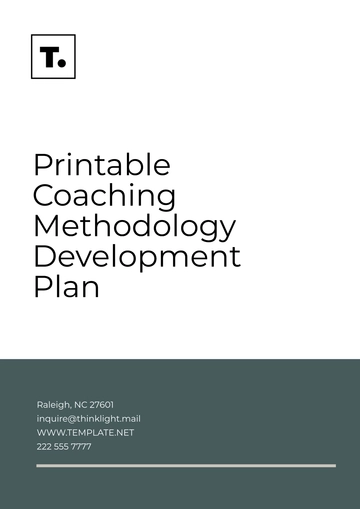Free Legal Corporate Policy Development Plan

I. Overview
Compliance with relevant legal regulations is a fundamental aspect of any business operation. It not only safeguards the company’s credibility with stakeholders but also mitigates potential legal risks. A comprehensive and robust legal corporate policy serves as the backbone of this compliance, ensuring that the company’s operations align with all applicable legal requirements. This Plan outlines key steps towards formulating such a policy, providing a strategic roadmap for the company.
In today’s dynamic business environment, legal regulations are constantly evolving. Staying abreast of these changes and ensuring compliance can be a challenging task. However, with a well-defined legal corporate policy, a company can navigate this complex landscape more effectively. The policy serves as a guide, helping the company understand its legal obligations and implement appropriate measures to fulfill them. It fosters a culture of compliance within the company, where every action is guided by a commitment to legal and ethical conduct.
This Plan is designed to guide the company through the process of developing and implementing a legal corporate policy. It provides a step-by-step approach, starting from an initial assessment of the company’s current compliance status to the implementation and regular review of the policy. By following this Plan, the company can ensure that its operations remain compliant with all relevant legal regulations, thereby protecting its reputation and credibility with stakeholders. The Plan underscores the company’s commitment to legal compliance, reinforcing its position as a responsible and ethical business entity.
II. Purpose and Scope
A. Purpose
The primary purpose of this Plan is to guide the company in the development and implementation of a comprehensive legal corporate policy. This policy is intended to ensure that the company’s operations align with all relevant legal regulations, thereby safeguarding its credibility and reputation. The Plan aims to provide a strategic roadmap, outlining key steps towards the formulation of a robust policy that not only addresses current legal requirements but is also adaptable to future changes in the regulatory landscape.
Moreover, the Plan underscores the company’s commitment to legal compliance and ethical conduct. By following the Plan, the company demonstrates its dedication to operating within the bounds of the law, fostering a culture of integrity, and maintaining the trust of its stakeholders.
B. Scope
The scope of the plan is comprehensive, encompassing all areas of the company’s operations that are subject to legal regulations. This includes:
Corporate Governance: The Plan covers all aspects of corporate governance, including board operations, shareholder relations, executive compensation, and disclosure requirements. It ensures that the company’s governance practices align with legal requirements and best practices.
Human Resources: The Plan includes all legal regulations related to human resources, such as employment laws, health and safety regulations, and anti-discrimination laws. It guides the company in creating a safe, fair, and inclusive workplace.
Financial Operations: The Plan encompasses all legal requirements related to the company’s financial operations. This includes regulations related to financial reporting, tax compliance, and anti-money laundering measures.
Environmental Compliance: The Plan covers all environmental regulations applicable to the company’s operations. It guides the company in minimizing its environmental impact and promoting sustainability.
The scope of the Plan also extends to the involvement of all levels of the organization in ensuring legal compliance. This includes:
Board of Directors: The board of directors plays a crucial role in setting the company’s compliance strategy and overseeing its implementation. The Plan provides guidance on how the board can fulfill its compliance-related responsibilities.
Senior Management: Senior management is responsible for implementing the company’s compliance strategy and ensuring that all operations align with legal requirements. The Plan outlines the key compliance responsibilities of senior management.
Employees: All employees have a role to play in ensuring legal compliance. The Plan provides guidance on how employees can contribute to the company’s compliance efforts, such as adhering to company policies, participating in training programs, and reporting compliance concerns.
III. Policy Development Plan
The policy development process is a systematic and comprehensive approach to creating a robust legal corporate policy. It involves several key steps, each of which contributes to the overall effectiveness of the policy.
A. Initial Assessment
The initial assessment is the first step in the policy development process. It involves three key activities:
Current Compliance Status Evaluation: This involves a thorough review of all existing corporate policies and practices to understand the company’s current position in regard to legal compliance.
Gap Identification: This involves identifying potential gaps in the company’s current compliance efforts. These gaps could be areas where the company’s policies or practices do not fully address applicable legal requirements.
Legal Requirements Review: This involves conducting a comprehensive review of all legal requirements applicable to the company’s operations. The aim is to ensure that the policy development process takes into account all relevant regulations.
B. Development Team Formation
The formation of a development team is a critical step in the policy development process. The team will be responsible for creating, integrating, and implementing the legal corporate policy. The team should include representatives from various areas of the company to ensure a diverse range of perspectives and expertise. The following table outlines the key roles and responsibilities of the development team:
Role | Responsibilities |
|---|---|
Legal Experts | Provide expertise on legal requirements and best practices |
HR Personnel | Ensure that the policy aligns with HR practices and employment laws |
Key Department Representatives | Provide insights into department-specific compliance needs |
The formation of a diverse and knowledgeable development team is crucial for the creation of a comprehensive and effective legal corporate policy. The team brings together a range of perspectives and expertise, ensuring that the policy addresses all relevant legal requirements and is practical and applicable to the company’s operations.
Moreover, the involvement of representatives from key departments ensures that the policy takes into account the specific compliance needs of different areas of the company’s operations. This not only enhances the relevance of the policy but also facilitates its acceptance and implementation across the company.
C. Legal Compliance Benchmarking
Benchmarking is a process of comparing the company’s current legal compliance measures against industry standards. This process involves three key steps:
Industry Standards Comparison: This involves comparing the company’s current compliance measures with those of other companies in the same industry. The aim is to identify areas where the company’s compliance efforts fall short of industry standards.
Best Practices Identification: This involves identifying best practices in legal compliance from leading companies in the industry. These practices can provide valuable insights that can help improve the company’s own compliance efforts.
Benchmarking Analysis: This involves analyzing the results of the benchmarking process to understand the gaps in the company’s current compliance efforts and the steps needed to close these gaps.
D. Creating the Policy Draft
Creating the policy draft is a crucial step in the policy development process. It involves three key activities:
Draft Creation: The development team uses the inputs from the initial assessment, benchmarking, and brainstorming sessions to create a draft of the Legal Corporate Policy. The draft should comprehensively address all legal requirements and guidelines relevant to the business operations.
Policy Review: The draft policy is then reviewed to ensure that it is clear, comprehensive, and practical. Any necessary revisions are made based on this review.
Legal Review: A legal review of the draft policy is conducted to ensure that it fully complies with all applicable laws and regulations.
E. Stakeholder Feedback
Collecting and incorporating stakeholder feedback is an important part of the policy development process. It involves three key steps:
Feedback Collection: The draft policy is shared with company stakeholders, including board members, managers, and possibly employees, for feedback. Their insights can bolster the policy’s relevance and applicability.
Feedback Analysis: The feedback received is analyzed, and necessary changes to the policy are identified.
Policy Revision: The policy is revised based on the feedback received. This ensures that the policy is not only legally compliant but also practical and relevant to the company’s operations.
F. Redrafting and Finalizing the Policy
Once the necessary changes have been incorporated based on stakeholder feedback, the policy is redrafted and finalized. This involves three key steps:
Policy Redrafting: The policy is redrafted to incorporate the necessary changes. The redrafted policy should be clear, practicable, and designed to ensure legal compliance in all aspects of the business.
Final Review: A final review of the policy is conducted to ensure that it addresses all feedback and fully complies with all legal requirements.
Policy Finalization: The Legal Corporate Policy is then finalized. The finalized policy should be ready for implementation and communication to all employees.
G. Implementation and Communication
Once the policy is finalized, it needs to be effectively implemented and communicated to all employees. This involves three key activities:
Policy Implementation: The finalized policy is implemented across the company. This involves integrating the policy into the company’s operations and ensuring that all employees adhere to it.
Communication Strategy Development: A communication strategy is developed to ensure that all employees are aware of the new policy and understand its implications. This could involve information sessions, training programs, and regular updates.
Training Programs: Training programs are conducted to educate employees about the policy and their responsibilities under it. This ensures that all employees understand and adhere to the policy.
H. Regular Review
Given the dynamic nature of law, the policy needs to be reviewed regularly. This involves three key steps:
Review Schedule Development: A schedule for regular reviews of the policy is developed. This ensures that the policy remains up-to-date with the latest legal requirements and industry standards.
Review Process: The reviews are conducted in a systematic and thorough manner. This involves assessing the effectiveness of the policy in ensuring legal compliance and identifying any areas that need improvement.
Policy Updates: Based on the review, the policy is updated as necessary. This ensures that the policy remains effective and relevant in the face of changing legal requirements and business conditions.
IV. Timeline
The timeline for the policy development process is a crucial component of the lan. The following table outlines the estimated duration for each step of the policy development process:
Steps | Estimated Duration |
|---|---|
Initial Assessment | 1-2 Weeks |
Development Team Formation | 1 Week |
Legal Compliance Benchmarking | 3-4 Weeks |
Creating the Policy Draft | 1-2 Months |
Stakeholder Feedback | 2-3 Weeks |
Redrafting and Finalizing the Policy | 3-4 Weeks |
Implementation and Communication | 1-2 Months |
Regular Review | Every 6 Months |
The timeline serves as a roadmap for the policy development process. It provides a clear sequence of activities, helping the development team stay organized and focused. Each step of the process is allocated a specific timeframe, ensuring that the team has sufficient time to complete each activity without rushing.Moreover, this timeline helps set realistic expectations for the policy development process. It provides a clear picture of the time and resources required for each step, helping the company plan and allocate resources effectively. By following the timeline, the company can ensure that the policy development process is completed in a timely manner, without compromising on the quality or comprehensiveness of the policy.
V. Conclusion
This Legal Corporate Policy Development Plan is a strategic roadmap that guides the company in ensuring its operations align with all relevant legal regulations. By following this Plan, the company can develop a comprehensive and robust legal corporate policy that addresses current legal requirements and is adaptable to future changes in the regulatory landscape. The Plan underscores the company’s commitment to legal compliance and ethical conduct, demonstrating its dedication to operating within the bounds of the law, fostering a culture of integrity, and maintaining the trust of its stakeholders.
The Plan provides a structured approach to policy development, ensuring that the process is systematic, thorough, and effective. It recognizes the dynamic nature of legal regulations and incorporates provisions for regular review and updating of the policy. This ensures that the policy remains up-to-date with the latest legal requirements and industry standards, thereby safeguarding the company’s legal compliance status in the long run. By following this Plan, the company can mitigate potential legal risks, maintain its credibility with stakeholders, and foster a culture of compliance and ethical conduct.
- 100% Customizable, free editor
- Access 1 Million+ Templates, photo’s & graphics
- Download or share as a template
- Click and replace photos, graphics, text, backgrounds
- Resize, crop, AI write & more
- Access advanced editor
Foster strategic development without the hassle with the Legal Corporate Policy Development Plan Template brought to you by Template.net! This editable plan ensures seamless customization through the intuitive AI Editor Tool. Optimize your policy initiatives with ease, providing a comprehensive and customizable source to guide organizational growth! Get started immediately!





























